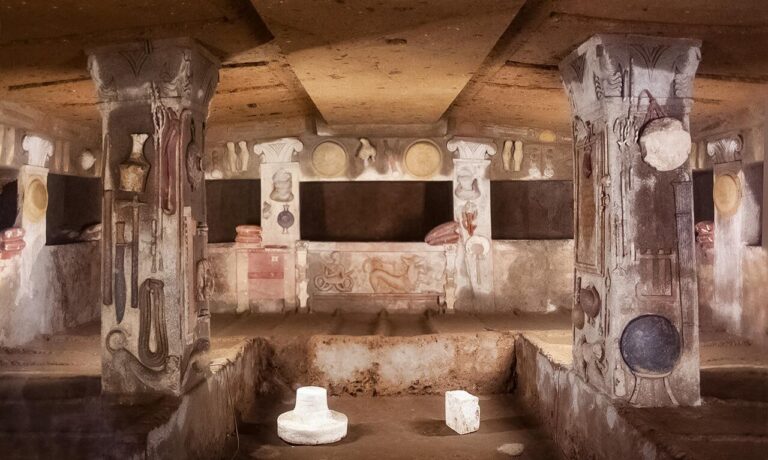Archaeologists have made a remarkable discovery at the Necropolis of San Giuliano in Italy: an intact Etruscan tomb dating back over two millennia. Unearthed during a recent excavation, the tomb offers an unprecedented glimpse into the ancient civilization that once thrived in the region, shedding new light on Etruscan burial practices and artistry. This rare find, announced by the archaeological team this week, is poised to deepen our understanding of one of Italy’s most enigmatic cultures.
Rare Etruscan Tomb Unearthed at Necropolis of San Giuliano Sheds Light on Ancient Burial Practices
Archaeologists have uncovered an exceptionally well-preserved Etruscan tomb at the Necropolis of San Giuliano, located just outside modern-day Italy’s Tuscany region. This rare discovery offers invaluable insights into the funerary customs of the Etruscan civilization, which flourished between the 8th and 3rd centuries BCE. The tomb contains elaborate wall paintings and a variety of burial artifacts that highlight the intricate rituals performed to honor the deceased. Among the findings are ceramic vessels, bronze jewelry, and intricately carved stone sarcophagi, which suggest a complex spiritual belief system intertwined with daily life and social status.
Key elements revealed by the excavation include:
- Iconography: Scenes depicting banquets and mythological motifs believed to guide souls in the afterlife.
- Architectural Design: A multi-chambered layout with distinct areas for family members, reflecting social hierarchy.
- Grave Goods: Objects intended for use in the afterlife, signifying the importance of material wealth beyond death.
This discovery not only enriches understanding of Etruscan burial traditions but also provides a tangible connection to one of ancient Italy’s most enigmatic cultures. Further analysis is underway to decode the symbolism in the tomb’s frescoes and to better understand the societal context behind these burial practices.
| Artifact | Material | Purpose |
|---|---|---|
| Ceramic Krater | Terracotta | Holding wine for funerary rites |
| Bronze Fibula | Bronze | Clothing fastener, symbol of status |
| Sarcophagus | Stone | Housing the body of the deceased |
Archaeologists Reveal Artifacts and Inscriptions Offering New Insights into Etruscan Civilization
Archaeologists working at the Necropolis of San Giuliano have uncovered a remarkably intact Etruscan tomb, shedding new light on the civilization’s funerary customs and artistic achievements. Among the wealth of artifacts were exquisitely preserved ceramics, bronze tools, and vibrant fresco fragments that depict intricate scenes from daily life and religious rituals. Inscriptions found on several pottery pieces reveal previously unknown dialectical variations and offer clues about Etruscan social hierarchies and trade relationships.
Key findings from the site include:
- Bronze Amulets: Bearing engraved symbols linked to Etruscan deities.
- Inscribed Funerary Stelae: Featuring epitaphs in Etruscan script, aiding linguistic research.
- Painted Ceramics: Representing myths not documented in Greek or Roman sources.
| Artifact | Material | Estimated Date |
|---|---|---|
| Bronze Dagger | Bronze | 7th Century BCE |
| Ceramic Vase | Terracotta | 6th Century BCE |
| Engraved Tablet | Stone | 5th Century BCE |
Experts Call for Enhanced Preservation Efforts to Protect Italy’s Cultural Heritage Site
Archaeologists and cultural preservationists have expressed urgent concern over the increasing threats facing Italy’s invaluable heritage sites, particularly following the remarkable discovery of an intact Etruscan tomb at the Necropolis of San Giuliano. Experts emphasize that without immediate and intensified conservation efforts, sites like these risk irreversible damage from natural erosion, urban expansion, and insufficient funding. The finding underscores the need for enhanced collaboration between government bodies, local communities, and international organizations to safeguard these cultural treasures for future generations.
To address these challenges, specialists advocate for a multi-faceted approach encompassing:
- Advanced monitoring technology to track environmental changes and human impact.
- Community engagement programs that foster local stewardship and awareness.
- Legislative reinforcement to tighten protections and ensure sustainable tourism.
| Preservation Strategy | Key Benefit |
|---|---|
| Digital Documentation | Permanent records for research and restoration |
| Climate Control Measures | Minimizes damage from humidity and temperature shifts |
| Educational Outreach | Raises public support and funding opportunities |
In Conclusion
The discovery of the intact Etruscan tomb at the Necropolis of San Giuliano marks a significant breakthrough in the study of ancient Italic civilizations. As archaeologists continue their meticulous work, this rare find promises to shed new light on Etruscan burial practices and cultural heritage. The ongoing excavation not only enriches our understanding of Italy’s archaeological landscape but also offers an invaluable glimpse into a civilization that has long fascinated historians and scholars worldwide. Further updates are anticipated as researchers analyze the artifacts and inscriptions contained within this remarkable tomb.




